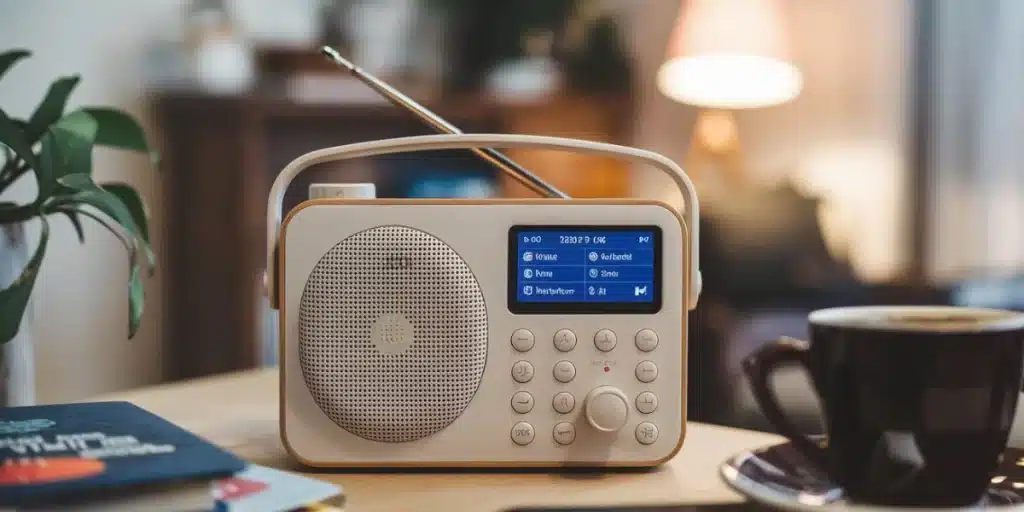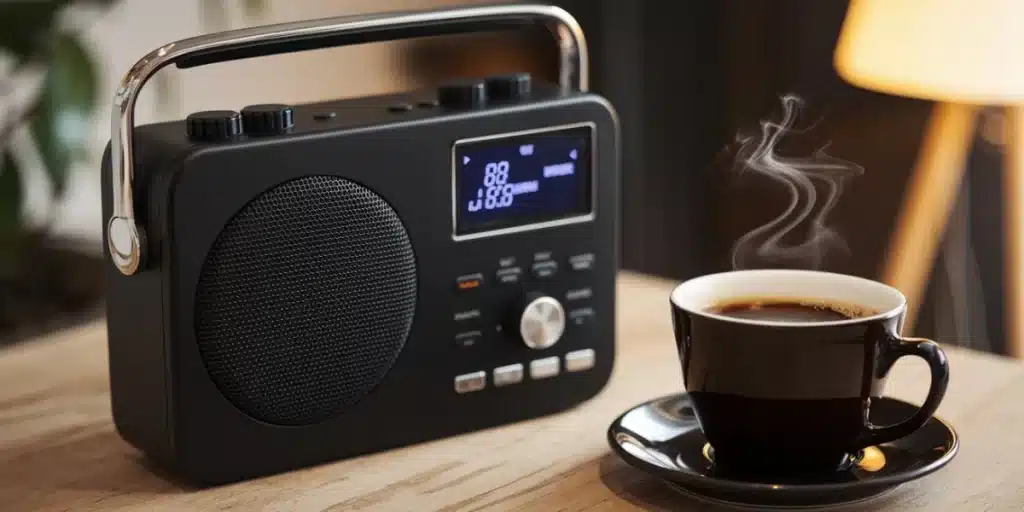What is DAB Radio?
DAB Radio, or Digital Audio Broadcasting, is a digital technology for broadcasting radio stations. Unlike traditional AM and FM radio, which use analog signals, DAB transmits digital audio, offering clearer sound quality, more station options, and additional features like song titles and program information. It allows broadcasters to send multiple stations over the same frequency, improving efficiency. DAB+ is an upgraded version of DAB, offering even better compression and sound quality. DAB is widely used in Europe, Australia, and parts of Asia, with increasing global adoption.

The Origins and Evolution of DAB Radio
To understand DAB radio, it’s important to first look at the history of radio broadcasting. Traditional radio broadcasting has been based on amplitude modulation (AM) and frequency modulation (FM), technologies that have been in use for over a century. While AM and FM radio have served listeners well, they come with certain limitations, including susceptibility to interference, limited bandwidth, and varying sound quality depending on the strength of the signal.
In the late 1980s, the need for a more advanced and efficient form of radio broadcasting became apparent. European engineers began working on digital radio technologies to address these limitations, and by the early 1990s, DAB radio was introduced as a promising solution. The first public DAB broadcast took place in 1995 in Norway, and by the late 1990s and early 2000s, many countries in Europe had adopted the technology.
The Development of DAB+
While the initial DAB technology was a major improvement over analog radio, it still had some drawbacks, such as relatively high energy consumption and inefficiencies in data compression. In 2007, DAB+ was introduced as an enhanced version of DAB radio. DAB+ uses the more efficient AAC+ codec for audio compression, allowing more stations to be broadcast on the same frequency and improving sound quality while consuming less power.
Today, DAB+ has largely replaced the original DAB standard in many countries, and it has become the dominant form of digital radio broadcasting in Europe, Australia, and parts of Asia. In the UK, for example, DAB+ is the default standard for most new radios and car audio systems.
How Does DAB Radio Work?
At its core, DAB radio is a method of transmitting digital audio signals over the airwaves, using digital compression technology to send data more efficiently than traditional analog broadcasting. Here’s how the process works:
- Digital Signal Encoding: Instead of sending analog sound waves like FM or AM radio, DAB broadcasts digital data packets. These packets contain encoded audio information, along with metadata such as station names, program schedules, and song titles.
- Multiplexing: DAB uses a process called multiplexing to combine several audio streams (radio stations) into a single transmission. This allows multiple stations to be broadcast on the same frequency, which is one of the reasons why DAB offers more station choices.
- Transmission: The multiplexed digital signal is then transmitted over a specific frequency using a network of transmitters. These transmitters can cover large areas and provide more consistent signal quality compared to analog systems.
- Reception and Decoding: A DAB radio receiver decodes the digital signal and converts it into audio that can be heard by the listener. Because the signal is digital, there is no loss of quality due to interference or distance from the transmitter, resulting in a cleaner, more consistent listening experience.
- Error Correction: DAB radio employs error correction techniques to minimize the impact of signal degradation or interference. This means that even if the signal is weak, the radio can still reconstruct the original audio with minimal distortion.
The Benefits of DAB Radio
One of the main reasons DAB radio has gained widespread popularity is the range of benefits it offers over traditional analog broadcasting. Let’s take a look at some of the key advantages of DAB radio:
1. Improved Sound Quality
DAB radio generally offers better sound quality than FM or AM radio because it uses digital signals. The digital format reduces background noise, interference, and distortion that often plague analog broadcasts. While DAB radio sound quality is not necessarily high-definition (it’s typically equivalent to MP3-level audio), it’s clear, consistent, and free from static.
2. More Station Choices
One of the standout features of DAB radio is the sheer number of stations available. By using multiplexing, broadcasters can fit many more stations into the available spectrum than is possible with FM or AM radio. This means listeners have access to a broader range of content, including niche music genres, talk shows, and specialty programming that wouldn’t normally be available on analog radio.
3. Enhanced User Experience
DAB radios often come equipped with features that enhance the listening experience, such as:
- Station Names: Unlike FM radio, where listeners have to remember station frequencies, DAB radios display station names, making it easier to browse and select stations.
- Program Information: Many DAB radios show program schedules, song titles, and artist information directly on the screen, so listeners know exactly what they’re hearing.
- Pause and Rewind: Some advanced DAB radios allow users to pause live radio broadcasts or rewind to hear something again, much like a DVR for radio.

4. Better Reception
DAB radio provides more reliable and consistent reception compared to analog FM or AM radio. While FM signals degrade as you move away from the transmitter, resulting in static or poor sound quality, DAB signals maintain their quality until they are completely out of range. Additionally, the use of error correction means that minor signal issues don’t affect the listening experience as much.
5. Energy Efficiency
DAB+ is more energy-efficient than traditional analog radio, both in terms of transmission and reception. Because DAB+ uses more advanced compression algorithms, broadcasters can transmit more data using less power, reducing their overall energy consumption. Additionally, DAB+ radios are designed to be more power-efficient, making them more environmentally friendly.
6. Future-Proofing
Many countries are phasing out or reducing their reliance on analog FM and AM radio in favor of digital formats like DAB. Investing in a DAB radio ensures that listeners are prepared for the future of broadcasting, particularly in regions where analog radio is being switched off.
The Limitations of DAB Radio
While DAB radio offers many advantages, it’s not without its limitations. Here are some of the key challenges and drawbacks of the technology:
1. Variable Sound Quality
Although DAB generally offers better sound quality than FM radio, the actual quality can vary depending on the bitrate used by broadcasters. Some stations may use lower bitrates to fit more content into the available bandwidth, which can result in sound quality that is comparable to or worse than FM radio. Additionally, DAB radios typically do not support high-resolution audio formats, so audiophiles may be disappointed.
2. Coverage Gaps
While DAB radio provides better reception than FM in many cases, it is still dependent on a network of transmitters. In rural areas or regions with poor infrastructure, DAB coverage may be limited or nonexistent. Listeners in these areas may experience dropouts or be unable to access certain stations.
3. Compatibility Issues
DAB+ is not backwards compatible with older DAB radios, which can be a problem for early adopters of the technology. While most new DAB radios support DAB+, those with older DAB radios may need to upgrade to access the latest stations and features.
4. Higher Initial Costs
DAB radios can be more expensive than their FM/AM counterparts, particularly for models with advanced features like pause and rewind functionality. While the cost of DAB radios has decreased over time, they still represent a higher upfront investment for consumers compared to traditional radios.
DAB Radio Around the World
DAB radio has seen varying levels of adoption across different regions, with some countries fully embracing the technology and others lagging behind.
Europe
Europe is at the forefront of DAB adoption, with countries like Norway, Switzerland, Germany, and the UK leading the charge. In Norway, for example, FM radio has been completely phased out in favor of DAB, making it one of the first countries in the world to do so. In the UK, DAB is widely available, and it is estimated that over 65% of all radio listening is now done via digital platforms, including DAB.
Australia
Australia has also been a strong proponent of DAB radio, with DAB+ being introduced in major cities in 2009. The technology has become increasingly popular, particularly in urban areas, where it offers better sound quality and more station choices than analog FM radio.
Asia
In Asia, DAB radio adoption has been more mixed. While South Korea and Hong Kong have introduced DAB services, other countries like Japan have been slower to embrace the technology, preferring to rely on analog FM and newer internet-based streaming services.
North America
DAB radio has had limited success in North America, where the HD Radio system is more commonly used for digital broadcasting. HD Radio is an alternative digital radio standard that allows broadcasters to transmit both analog and digital signals simultaneously on the same frequency. However, DAB radio has not gained significant traction in the United States or Canada, where internet radio and satellite radio services like SiriusXM are more popular.

The Future of DAB Radio
As digital technologies continue to evolve, the future of DAB radio looks promising. Many countries are planning to phase out analog FM and AM radio
in the coming years, and DAB radio is expected to play a key role in this transition. However, DAB radio will also face competition from newer technologies, such as internet radio, podcasting, and music streaming services.
One of the key challenges for DAB radio will be staying relevant in a world where listeners have increasingly diverse options for consuming audio content. With smartphones, smart speakers, and connected cars providing easy access to internet-based radio and on-demand content, DAB radio will need to continue offering unique benefits, such as free-to-air broadcasting, reliability, and ease of use.
Conclusion
DAB radio represents a significant advancement over traditional analog radio broadcasting. By offering improved sound quality, more station choices, and enhanced features, it has transformed the radio listening experience for millions of people around the world. While there are some limitations to the technology, such as variable sound quality and coverage gaps, DAB radio is a future-proof solution that is likely to remain a key part of the broadcasting landscape for years to come. As the world moves toward a digital future, DAB radio stands as a vital component of the ongoing evolution of radio.
FAQs
1 How is DAB different from FM/AM radio?
DAB transmits digital signals, offering better sound quality and more stations on the same frequency. FM/AM uses analog signals, which are more prone to interference and static.
2 What is DAB+?
DAB+ is an improved version of DAB radio, using advanced compression to deliver better sound quality and more efficient broadcasting.
3 Can I use a DAB radio anywhere?
DAB radio is available in many countries, but coverage may vary by region. In rural areas, signal strength may be weaker compared to urban locations.
4 Do I need a special radio for DAB?
Yes, you need a DAB-enabled radio to receive digital broadcasts. Traditional FM/AM radios cannot receive DAB signals.
5 Is DAB radio free?
Yes, DAB radio is free to listen to, just like FM or AM radio.
6 What are the benefits of DAB Radio?
DAB offers clearer sound, more station choices, easier tuning with station names, and extra information such as song titles and program details.
7 Can I get DAB radio in my car?
Many modern cars come with DAB radios as standard, or you can buy an aftermarket DAB radio adapter.
8 Will DAB replace FM?
In some countries, DAB is gradually replacing FM radio, but the transition depends on regional broadcasting policies.
9 What if my area doesn’t have DAB coverage?
If DAB coverage is poor in your area, you can still listen to FM or AM radio, or use internet radio as an alternative.